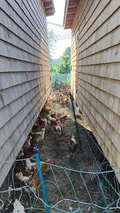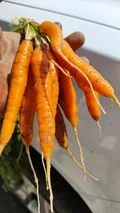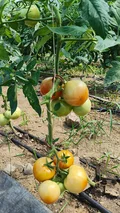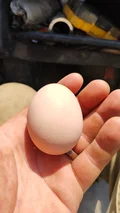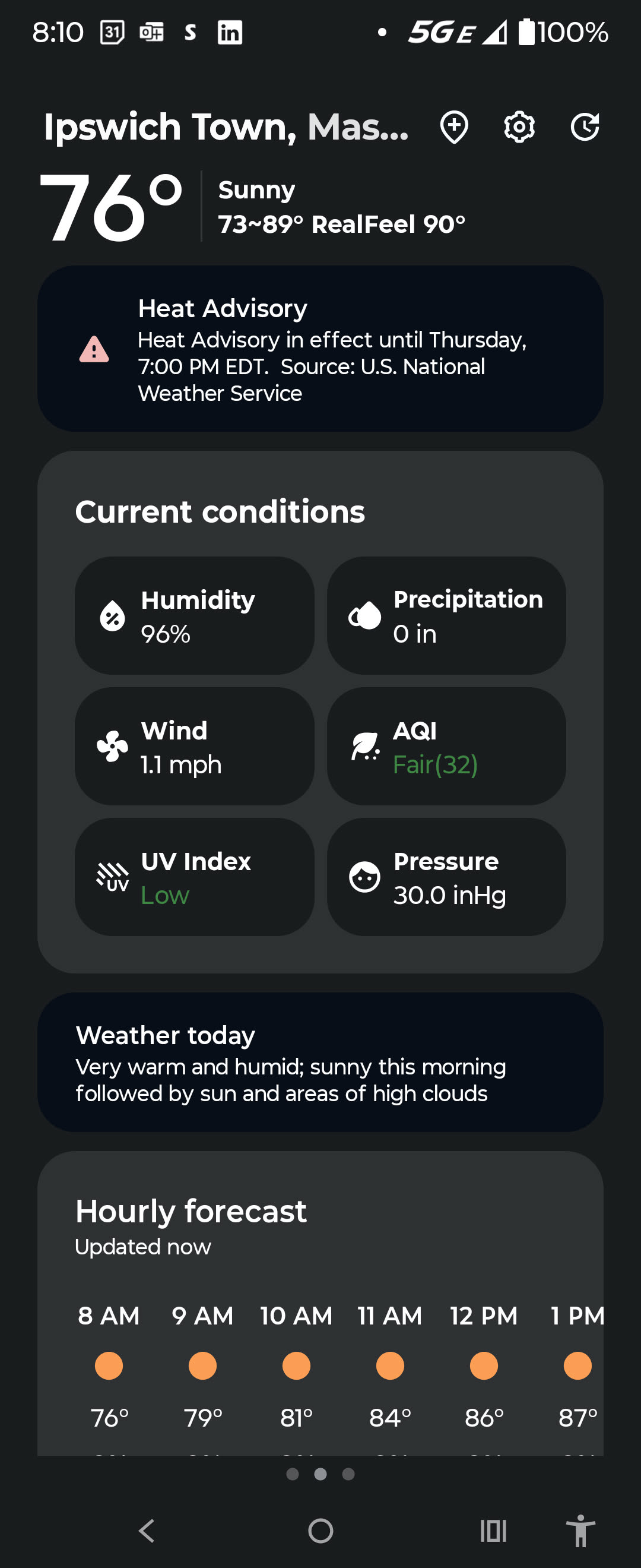TL;DR
We harvested Alisa Craig onions, carrots, and garlic this morning then we did odd jobs like irrigation repair and bunching before packing the vehicles for markets.
I also worked a bit on my local homelab and blogging infrastructure, patched a few infrequently appearing bugs, and started retrofitting my own LLMBO service to be usable as an Ollama proxy.
Only a Tenth of the Way in to All the Onions
We planted a lot of onions this year…like, a lot. The number was 13,500 when I asked back in mid-May. After two weeks of harvesting the earliest variety from the top of the main field, in my estimation we’re only about a tenth of the way through the harvest because those rows are about one-fifth. The rest are in the dry fields and of a different variety that will be used for storage.
It felt good to finally be done planting the onions. It will likely feel good to finally be done harvesting them too.
All Done Harvesting the Garlic
It’s nice to see the entire lifecycle of something that over-winters from year to year. Garlic is one of those things, having planted and mulched it in the fall last year, seeing it grow up and race the weeds, harvesting and hanging it to dry…I’ll be very happy for its tastiness in the winter.
First Eggs from the New Hens, Already!
Surprisingly, we got our first eggs from the new hens today. This is less than one week since they arrived and Jamie says that usually it takes two weeks or so. This is a good sign because our egg production will ramp up quickly now that we have a total flock of over 500 hens. And how the new 250 are rapidly growing…their appetite for anything edible is easily seen when you drop overgrown trays of seedlings off for them to eat in the morning and by mid-day its all gone.
Of all the farm animals I’ve experienced, I think chickens are the most productive. They fertilize the soil and provide eggs. They aren’t as dirty or smelly as pigs, and compared to cows they don’t require as much space or food inputs. Though they aren’t a source of high profit (despite the price of eggs), I think they’re worth it for every vegetable farm that can support moving mobile coops around every few weeks.
Everything Is in Production
The greenhouse is a ghost town, not a plant in there now that everything is out in the fields and temperatures are high. What’s left of the seedlings is small half-dozen successions of lettuces and other greens that will likely be planted in a few weeks to head in to early fall.
On a farm, everything is in one stage or another of it’s producing journey. The vegetables that start as seeds and become seedlings all have timings for when best to plant them which are dependent on the weather, the soil, the labor available, and the intended harvesting window. Necessarily things have to be incubating in order to reach production, but not everything incubating will. Some abundance eventually has to become compost or feed for the animals.
Unlike my prior experience in software engineering which only wanted to see things in production rapidly and never anything that looked like incubations, I think the lack of competence around appropriate buffers and timing in software development leads to problems in process variance and what to do in times of scarcity. Having “credible investments at the ready” was the idea from Dr. Geoffrey Moore that I built a small and short-lived practice on…and at the wrong company…which might have looked like a few extra seed trays more than was in production, but there’s a reason why the farmer builds a little extra in to the plan.
Yesterday’s Tech Problem, Fixed
Speaking of what happens when you don’t have a backup plan…
Whatever the reason my farm phone wasn’t retaining the photos I took yesterday, it worked fine today. My real phone took a tumble a while ago, but now the outside glass cracks are so bad that they spread to the camera lens so I can’t take pictures with that one without using the inside/selfie camera…not optimal. Both are Moto Flips and I’ve ordered a duplicate 2024+ model which will become my ‘don’t ever take this out of the car’ phone when I’m at the farm. Phones that fold up don’t take kindly to the dirt and water frequently encountered in the field.
The photos are important to me for a few reasons:
- They’re a visual to accompany this writing
- The farm business can use them freely, as can others
- They are future training data for Agro-specific vision models
Summarizing Field Notes with AI in Production
As I’ve been working with my homegrown services to transcribe and summarize my field notes, I’ve been thinking about how to make that process more efficient and accessible. Thought they’re all containerized and running as pods on Kubernetes…something that at least proves they are portable to other environments…the intra-dependencies can get a bit tricky. So I’ve been thinking about how to make each of these services as multi-environment as possible; for instance, how can Autoscribe either use LLMBO or Ollama directly?
To answer this question, I started in on building endpoints in LLMBO that mimic the Ollama REST API so I can easily point autoscribe and other components to LLMBO’s routing capability instead of a specific Ollama service address. Unfortunately, Ollama still ships without an OpenAPI spec, which is why you see user requests like #3487 and this sort of content grab of a Postman collection like this one.
I still think this is the right approach, but I’m going to need to spend some time with the Ollama codebase to see how to best implement it tomorrow. This way, I can open source the Autoscribe codebase and the average user can use Ollama while I use LLMBO internally. Eventually I would also open up that codebase as well.
For today, with bugs fixed and running as slow as ever on CPU instead of using LLMBO to offload the work to my laptop GPU, this is what my AI-assisted summarization process resulted in:
Summary
Consolidated Summary:
Main Themes:
- Farm Operations – Daily agricultural tasks, animal care, and logistical management.
- Return to Base – Final activity of the day, ensuring tasks are completed before returning to the main location.
Activities:
- Agricultural Tasks: Harvesting crops (e.g., garlic), maintaining greenhouses, repairing irrigation systems, watering pigs, and monitoring animal health.
- Logistics: Cleaning barns, equipment maintenance, and managing CSA (Community Supported Agriculture) operations.
- Logistical Management: Training dogs for tasks, documenting greenhouse conditions, and optimizing CSA logistics.
- Final Activity: Driving back to the main location to conclude the day’s work.
New Observations/Discoveries:
- Garlic Lifecycle: Understanding growth stages and yield optimization.
- Dog Behavior: Observing interactions with livestock or other animals.
- Irrigation Systems: Assessing efficiency and repair needs.
- Greenhouse Conditions: Tracking environmental factors and plant health.
- Pig Recovery Monitoring: Documenting health metrics and productivity.
Key Questions:
- From Farm Operations:
- How to optimize garlic yield and manage its lifecycle?
- What are the behavioral patterns of the dogs?
- How to improve irrigation system performance?
- What are the greenhouse’s environmental conditions?
- How to effectively monitor pig recovery?
- From Return to Base:
- What is the purpose of the drive back?
- What tasks were completed before returning?
Suggested Actions:
- From Farm Operations:
- Train dogs for specific tasks (e.g., monitoring livestock).
- Upgrade irrigation systems for efficiency.
- Document greenhouse conditions for analysis.
- Optimize CSA logistics for better resource allocation.
- Implement regular pig health checks.
- From Return to Base:
- Clarify workflow to ensure all tasks are completed before returning.
- Expand notes for detailed record-keeping and task tracking.
This summary integrates all activities, observations, and recommendations from both documents, providing a cohesive overview of the farm’s operations and the intern’s responsibilities.
Part 1
Main Themes
- Chicken Management and Acclimation:
- New chickens are not yet compatible with old hens, leading to bullying and social tension.
- New hens are not yet laying eggs, but two eggs were found, indicating progress.
- Water system issues (nozzle problem) were resolved.
- Harvesting and Produce Quality:
- Onions (Elise Craig variety) were harvested, with emphasis on freshness and marketing value.
- Carrots require careful handling due to their fragility and the importance of green tops for freshness.
- Observations and Concerns:
- New chickens need time to adapt to the farm environment.
- Carrot greens turn brown quickly, affecting marketability.
Activities Performed by the Intern
- Chicken Chores:
- Provided water and hay for chickens.
- Checked for conflicts between new and old hens.
- Ensured water system (nozzle) was fixed.
- Monitored egg-laying (two eggs found).
- Harvesting:
- Pulled onions (4–5 blue buckets = ~2 green tote containers).
- Pulled carrots, carefully removing greens and handling roots to avoid damage.
- General Farm Work:
- Documented observations about chicken behavior and produce quality.
New Things Not Yet Encountered
- Chicken Social Dynamics:
- New chickens being bullied by older hens (conflict between groups).
- New hens not yet laying eggs (early stage of acclimation).
- Produce Handling Challenges:
- Carrot greens turning brown quickly (due to temperature or time).
- Carrot roots being fragile and prone to breaking.
- Water System Issue:
- A malfunctioning nozzle in the chicken watering system.
Questions and Future Research Areas
- Chicken Acclimation:
- How long does it take for new hens to fully adapt to the farm environment?
- What factors (e.g., temperature, noise, social structure) influence their behavior?
- Egg-Laying Timeline:
- Why did the new hens lay eggs so quickly (only 1 week post-arrival)?
- How does their age and prior indoor environment affect this?
- Carrot Greens and Freshness:
- How does temperature affect the shelf life of carrot greens?
- Is there a way to preserve green tops without compromising quality?
- Water System Reliability:
- What caused the nozzle issue, and how can it be prevented in the future?
Suggestions for Action
- Fix Water System:
- Repair the nozzle issue immediately to ensure consistent water access for chickens.
- Monitor Chicken Behavior:
- Continue observing interactions between new and old hens to ensure they acclimate safely.
- Improve Carrot Handling:
- Develop a method to preserve carrot greens (e.g., timing of harvest, storage conditions).
- Track Egg-Laying Progress:
- Keep a log of egg production from new hens to assess their adaptation timeline.
- Document Produce Quality:
- Record how quickly carrot greens turn brown under different conditions (e.g., temperature, humidity).
Part 2
Main Themes:
- Agricultural Operations: Garlic harvesting, irrigation repair, greenhouse maintenance, and crop management.
- Animal Management: Dog behavior, cow interactions, and pig care.
- Farm Logistics: CSA pickup preparation, equipment maintenance, and daily farm routines.
- Observational Learning: Tracking the life cycle of garlic, from planting to harvest, and understanding farm systems.
Activities Performed by the Intern:
- Washed carrots.
- Cleaned the barn.
- Harvested garlic (scapes and heads).
- Bunched garlic (10 heads per bundle, folded and elasticated).
- Dried garlic on metal wire.
- Maintained the greenhouse (noted its emptiness and stored pallets).
- Repaired irrigation tubing (repaired holes and replaced parts).
- Watered pigs.
- Monitored slow-developing pigs.
- Packaged a van for a CSA pickup (cabbage, carrots, bok choy, lettuce, beets, onions, summer squash, zucchini, eggs).
New Things Not Yet Encountered:
- Garlic Lifecycle Observation: From planting to harvest, including scapes, early shoots, and head formation.
- Dog Behavior: The dogs’ instinctive “protective” behavior toward cows, despite their small size.
- Irrigation System Components: Specific parts like tube adapters, belt tighteners, and the mechanics of irrigation hole development.
- Greenhouse Use: The greenhouse’s current emptiness and its role as a storage area for unused materials.
- Pig Recovery Monitoring: Observing pigs that are lagging in growth and determining factors affecting their recovery.
Questions and Future Research Areas:
- Dog Behavior: Why do the dogs act aggressively toward cows, and how can this be managed?
- Irrigation System Longevity: Why do holes form in irrigation tubing, and how can this be prevented?
- Pig Growth Patterns: What factors influence the recovery time of slow-developing pigs?
- Greenhouse Purpose: What is the greenhouse used for beyond storage, and how can it be utilized more effectively?
- Garlic Bunching Efficiency: How can the garlic bunching process be optimized for consistency and labor?
Suggested Actions:
- Train the Dogs: Implement training to reduce aggressive behavior toward cows, ensuring safety for both animals and humans.
- Improve Irrigation Maintenance: Schedule regular checks for irrigation tubing and replace damaged parts to prevent leaks or system failure.
- Monitor Pigs Closely: Track the pigs’ progress with a log to identify potential health or environmental issues affecting their growth.
- Document Greenhouse Use: Record the purpose of the greenhouse and its contents to streamline future use or repurposing.
- Optimize CSA Packing: Streamline the packing process for the van to ensure timely delivery and reduce labor.
Part 3
Main Themes:
- Farm Workday – The intern’s activities on the farm, culminating in the end of their day.
- Return to Main Area – The intern’s task of driving back to the main area, marking the conclusion of their workday.
Activities Performed by the Intern:
- Driving back to the main area – This appears to be the final activity of the day, though the transcript does not specify prior tasks.
New Things Not Yet Encountered:
- No specific new activities or observations are mentioned in the transcript. The intern’s note is brief and ends with the conclusion of their day, leaving little detail about tasks or experiences.
Questions and Future Research Areas:
- Purpose of the drive back – Why was the intern required to drive back to the main area? Was this part of a routine task or a specific activity?
- Tasks before the drive – What activities did the intern complete before driving back? The transcript does not clarify this.
- End of the day – What was the intern’s role or responsibility at the end of their shift?
Suggested Actions:
- Clarify the workflow – The intern should document or inquire about the sequence of tasks leading up to the drive back to the main area.
- Expand field notes – The intern should note more details about their activities, such as specific tasks or observations, to provide a clearer record of their workday.
[end of post]
Enjoy Reading This Article?
Here are some more articles you might like to read next:
